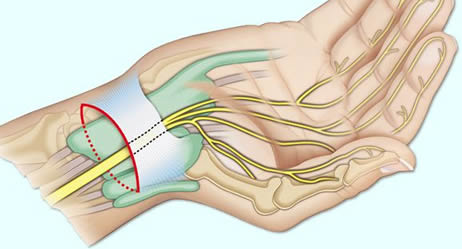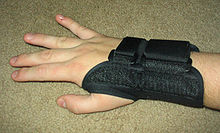Carpal Tunnel Syndrome
You’ve been plagued by numbness and tingling in your fingers and wrist. You are waking up at night with a “pins and needles” sensation in one hand? There might be other explanations, but the symptoms suggest you may have carpal tunnel syndrome. Is it dangerous? No. But to ignore the symptoms may cause damage of the nerve and the muscles. What is to do?
In carpal tunnel syndrome (CTS), one of the nerves to the hand (the median nerve) becomes compressed as it passes through the wrist. There are different causes which can lead to CTS like occupational overstressing of the hands, injuries at the wrist with malposition of the carpal bones, arthritis, pregnancy, diabetes, overweight and others. Also a genetic predisposition is discussed. In many cases, no single cause can be identified. It may be that a combination of risk factors contributes to the development of the condition.
Carpal Tunnel Syndrome Symptoms
The typical symptoms are numbness or tingling in the thumb, index, middle and ring finger, later pricking and painful paraesthesias. Sometimes the whole arm up to the shoulder is affected. This happens during the night or after awaking in the morning; but also with certain hand positions like keyboard typing, holding a phone or reading a newspaper, cycling or motor biking. The symptoms are intensified by overloading the hands by repetitive manual work. At the beginning the discomfort can be reduced by “shaking” the hands. Later a persistent numbness may occur. Left untreated, carpal tunnel syndrome can lead to constant pain and to permanent nerve and muscle damage that could severely limit your ability to use your hands.
Carpal Tunnel Syndrome Diagnostics
If you have persistent signs and symptoms, especially if they interfere with your normal activities and sleep patterns, you should see your neurologist.
Your doctor will conduct a neurological examination. Tests with pressure on the median nerve at the wrist, produced by bending the wrist (Phalen`s maneuver) or tapping on the nerve (Tinel`s sign) can bring on the symptoms in many people. Important is to prove the feeling in your fingers and the strength of the muscles in your hand. Nerve conduction studies (an electrodiagnostic test) can pinpoint damage to the median nerve by measuring how fast electrical impulses move through it. Up to 10 percent of people with carpal tunnel syndrome, however, test is normal when this method is used. Other examinations like electromyogramm, SEPs (sensory evoked potentials), ultra sonic or MRI might be necessary to rule out other conditions like nerve root irritation or compression at the cervical spine.
If you think that you want to fix something else related to your mental health. GNC Dubai is providing one of the best psychiatrists in Dubai, psychologists in Dubai and psychotherapists in Dubai who can help you find the core reason and in fixing it.




